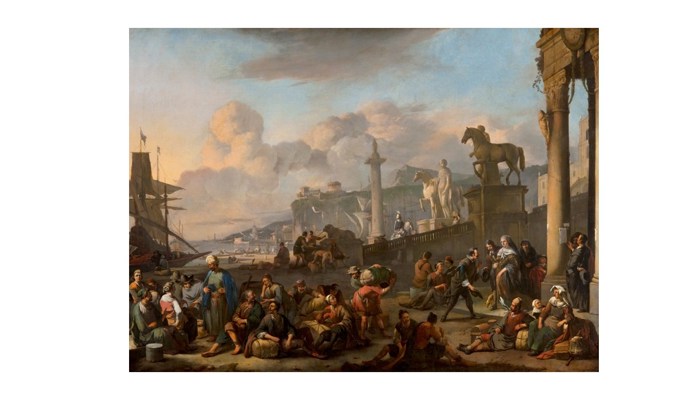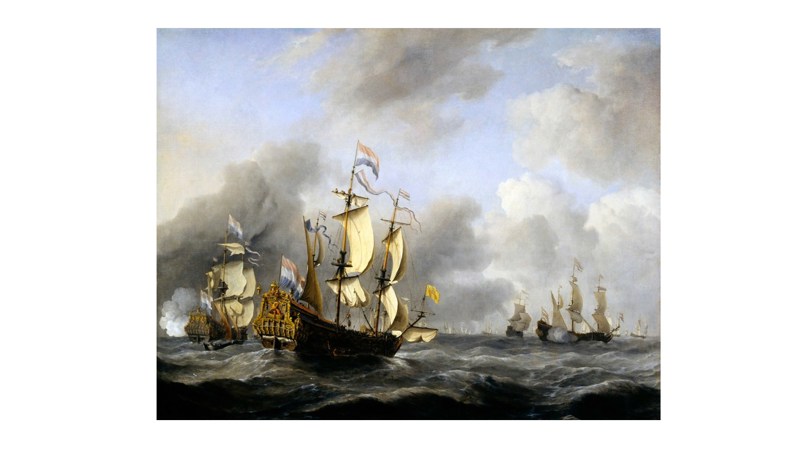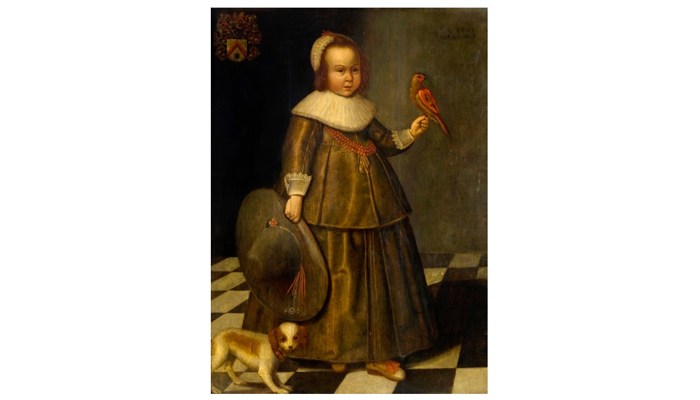
Rethinking the ‘Dutch Golden Age’

The ‘Eendracht’ and Other Ships of the Dutch Fleet, ascribed to Willem van de Velde II, 1673-1678
622
Images © CSG CIC Glasgow Museums Collection
17th November 2021
The Dutch ‘Golden Age’- the 17th century – is generally spoken of and written about as a time of prosperity, grandeur, and pride. Its citizens enjoyed wealth beyond compare, illustrated in some of the finest portraits in history by esteemed artists such as Rembrandt, Hals and van der Helst.
The reason for the wealth of the Dutch Republic is often described in hazy terms, with words like ‘naval strength’, ‘trade dominance’ and ‘mercantile control’ flying around as freely as the flags on the grand ships in paintings by marine artists such as Willem van de Velde.
The reality is that much of the Dutch wealth made during their ‘Golden Age’ was done so via the exploitation of Indigenous people, through the conquest and exploitation of their land, and the enslavement and sale of subjugated people. It is estimated that during the Dutch 200-year involvement in slavery, around 550,000 – 600,000 African people were transported at the hands of the Dutch. This equates to about 5-7% of the total 12 million Africans estimated to have been forced into slavery through the transatlantic slave trade.
The Dutch Republic, founded in 1581, furthered its colonial interests with the establishment of two companies: the United East India Company (VOC) and the Dutch West India Company (WIC). These two companies were intended to expand Dutch trade interests across the Indian Ocean and in the Dutch West Indies- the name then used for Brazil, Berbice, Demerary (Guyana), Essequibo, Surinam and the Antilles in the Caribbean. The two companies were given permission by the Dutch Republic to bear arms, to build forts, and to generally dominate both at sea and at land. They had a state monopoly on the trade of all kinds of goods including spices, sugar, textiles, cacao, and coffee, and made the Netherlands the most successful trading nation for the next 200 years.
Images


The WIC was involved in what is known as the triangular trade route: the Dutch sailed out from their homeland in ships packed with goods such as textiles, ammunition, gunpowder, and alcohol to trade in Africa. There, they exchanged these goods for human beings, who were then transported to South America and exchanged for goods such as gold, ivory, sugar, coffee and cacao. These goods were then taken back to the Netherlands and sold at great profit.
The human cost of this Dutch dominance was extremely grim. After being abducted from their native homes elsewhere in Africa, people were transported to fortresses. There, they were physically branded like cattle with scorching hot irons, and kept in dungeons, with around 1000 people held in rooms that were suitable for 200. They were held for up to three months without toilet facilities or water, before being sold at market in towns like Salaga, North Ghana, and on the island of Curacao. These enslaved Africans were taken from their homes by fellow Africans who were exploited by Europeans offering goods such as alcohol, guns and ammunition in exchange for the prisoners.
Enslaved people were then sent aboard cramped ships, travelling for months on end in hideous conditions to plantations in South America including today’s Colombia, Venezuela, Cuba, and Suriname, where they were forced to work. On those journeys it’s estimated that around 13% died from the inhumane conditions they were forced to endure at sea. In plantations run by White Europeans, these ‘survivors’ processed the raw materials such as sugar cane and coffee, which were then transported back by the Dutch for sale across the world. African enslaved people lived on average until the age of 23.
Back in the Dutch Republic, more and more burghers invested in these shameful activities. The VOC is recognised as the world’s first registered public company; a company owned by the public investing in bonds, stock and shares. It is regarded as the model that led to global capitalism. Burghers in the Dutch Republic could invest and profit from its success, becoming implicated in its activity. Other individuals were linked by running plantations, trading in the goods acquired, or by naval activity. Many of these individuals sought to have their wealthy status recorded for posterity by the great portrait artists of the time.
Until recently, these histories have been hidden behind a veneer of beautiful art and proud, Dutch trade dominance. The ill-gained wealth of these individuals – and indeed of the whole Dutch Republic – is rarely explored in our art galleries. Indeed, if we want to really tell the story of the ‘Golden Age’, we need to rethink the way art history is taught, as that whole period of history is so steadfastly described in terms of splendour and strength, rather than destruction and exploitation.
Museums across the world are finally beginning to rethink these histories. The Rijksmuseum in Amsterdam, which houses some of the world’s finest Dutch paintings, recently staged ‘Slaverij’, an exhibition exploring ten stories of slavery, told from different, human perspectives. Other museums have gone further, with the Amsterdam Museum taking the decisive action to stop using the term ‘Golden Age’ altogether, recognising that for many it was instead a time of torment and suffering.
It is time for Glasgow Museums to rethink its Dutch collection. We enjoy a rich and wonderful collection of art from this period, with names including Rembrandt, Hals, Van der Helst, and van der Velde all represented. There are stories waiting to be told, if we prod beneath the shiny exterior of the ‘Dutch Golden Age’. We are currently revising the words we use to describe the paintings and other objects in our collection, thinking about how we can tell the wider story of Dutch prosperity.
Pippa Stephenson-Sit,
Curator of European Art
